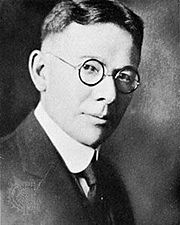Lewis Terman facts for kids
Quick facts for kids
Lewis Terman
|
|
|---|---|
 |
|
| Born |
Lewis Madison Terman
January 15, 1877 Johnson County, Indiana, U.S.
|
| Died | December 21, 1956 (aged 79) |
| Nationality | American |
| Alma mater | Clark University Indiana University Bloomington Central Normal College |
| Known for | IQ testing, Positive Psychology of Talent |
| Scientific career | |
| Fields | Psychology |
| Institutions | Stanford University Los Angeles Normal School |
| Doctoral students | Harry Harlow |
| Influences | Francis Galton, Wilhelm Wundt |
| Influenced | Frederick Terman |
Lewis Madison Terman (born January 15, 1877 – died December 21, 1956) was an American psychologist. He was a leader in educational psychology in the early 1900s. He worked at Stanford University.
Terman is famous for two main things. He updated the Stanford–Binet Intelligence Scales. This is a test that measures a person's IQ. He also started a long-term study called the Genetic Studies of Genius. This study followed children with high IQs throughout their lives. He was also the president of the American Psychological Association.
Contents
Early Life and Education
Lewis Terman was born in Johnson County, Indiana. He earned several degrees from different colleges. He received a Bachelor of Science (BS) and Bachelor of Pedagogy (BPd) in 1894. He also got a Bachelor of Arts (BA) in 1898 from Central Normal College.
Later, he earned a BA and Master of Arts (MA) from Indiana University Bloomington in 1903. He completed his PhD from Clark University in 1905.
Career Path
After finishing his studies, Terman worked as a school principal in San Bernardino, California in 1905. In 1907, he became a professor at Los Angeles Normal School.
In 1910, he joined Stanford University. He became a professor of educational psychology. He stayed at Stanford until he died. From 1922 to 1945, he was the head of the psychology department.
His son, Frederick Terman, also became very famous. He is known for helping to create Silicon Valley.
Key Achievements in Psychology
IQ Testing and the Stanford-Binet Scale
Terman made big changes to the Binet-Simon Scale in 1916. This test was first created by Alfred Binet and Théodore Simon in France. Terman's updated version was called the "Stanford-Binet." It helped identify children who needed special educational support.
Terman used William Stern's idea for the intelligence quotient (IQ). This was calculated by dividing a person's "mental age" by their "actual age" and multiplying by 100. The Stanford-Binet test is still used today to measure general intelligence in both kids and adults.
Intelligence Testing During World War I
During World War I, Terman helped the United States military. He was part of a team that gave IQ tests to 1.7 million soldiers. These tests helped the army decide what roles recruits would be best at.
Soldiers who scored high could become officers. Those with lower scores would not receive officer training. This large-scale testing showed Americans that intelligence tests could be useful in many areas. After the war, Terman wanted schools to use these tests to help students.
Studying Extreme Talent
Terman was very interested in gifted children. He wanted to find the best ways to educate them. He also wanted to prove that gifted children were not "conceited" or "weird."
He started a long-term study in 1921 called the Genetic Studies of Genius. This study followed children with very high IQs throughout their lives. It was published in five books. The study showed that gifted children were usually healthy and had normal personalities. They were often taller and better at social interactions than other kids.
These gifted children were sometimes called "Termites." Many of them became very successful in their jobs. They also had stable relationships. Terman found that most gifted children did not fit the negative ideas people had about them.
Terman died before finishing the fifth book of his study. His colleague, Melita Oden, completed it. Terman wanted the study to continue after his death. So, Robert Richardson Sears, one of the successful participants in the study, took over. Stanford University still supports this study today.
Importance of Challenging Tasks
In 1915, Terman wrote about the importance of challenging bright children. He believed that while intelligence is inherited, smart children need special schooling. He said that if bright children are not given hard enough tasks, they might not use their full abilities. This means that both a child's natural ability and their environment are important for their intelligence to grow.
Legacy and School Renaming
Lewis Terman was an elected member of important groups like the National Academy of Sciences.
A middle school in Palo Alto, California was named after Terman and his son. However, in 2018, the school board decided to change the name. This happened because people learned about Terman's controversial views on intelligence and heredity. The school was renamed after Ellen Fletcher, a former city councilwoman.
Frederick Terman, Lewis's son, became a provost at Stanford University. He helped grow the science and engineering departments. This greatly helped Stanford become a top university and boosted the growth of Silicon Valley.
See also
 In Spanish: Lewis Terman para niños
In Spanish: Lewis Terman para niños
- Cognitive epidemiology
- Aptitude
- Eugenics in the United States

